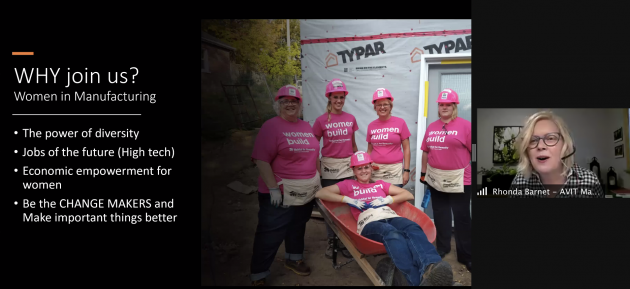
‘Change is happening’: 5 tips from the Women in Manufacturing Virtual Summit
May 25, 2021
By
Kristina Urquhart
The Manufacturing Group at Annex Business Media hosts online event focused on recruiting, retaining and advancing women in the sector
 The "Advancing women in leadership" panel at the Women in Manufacturing Virtual Summit. Photo: Annex Business Media
The "Advancing women in leadership" panel at the Women in Manufacturing Virtual Summit. Photo: Annex Business Media Creating an inclusive workforce is crucial to the competitiveness of Canadian manufacturing.
According to industry leaders who gathered to discuss gender equity in the sector at the inaugural Women in Manufacturing Summit on May 13, half of Canada’s population is being underused when it comes to mitigating the skills shortage.
“We have technology gaps, and we have skills gaps. We talk about these things and we make strategies,” said keynote speaker Rhonda Barnet, president and COO of AVIT Manufacturing. “But what are we doing to talk about business and cultural gaps in terms of fostering diversity and inclusion in our sector? We need to leverage the full population to compete and grow.”
Barnet kicked off three hours of lively panel discussions and presentations hosted by Annex Business Media’s Manufacturing Group, which drew a total of 520 registrants, with about 300 people attending in real time.
The event was supported by platinum sponsor Salesforce, and gold sponsors Build a Dream, Excellence in Manufacturing Consortium, IPEX by Aliaxis, Mouser Electronics and Nilfisk.
Missed the broadcast? Register for free to watch the recordings, and read on for our five key takeaways.
1. Measure it so you can manage it.
Barnet, who has long been a gender equity advocate for the manufacturing sector through her work at AVIT and the Canadian Manufacturers & Exporters (CME) association, called on leaders to make hiring, advancing and retaining women a priority.
“We need all of you to be champions of this cause to foster real change,” she said. “Change is happening, but it’s not happening nearly fast enough.”
In order to meaningfully break down the barriers that women face in the manufacturing workplace — such as the glass ceiling, business culture, bias among the workforce and lack of mentorship opportunities — companies must start tracking and reporting on their diversity performance, Barnet said.
She suggested tracking gender-based data within an organization, and creating a people-first EDI strategy that considers the culture around parental leave, mentorship, sponsorship, salary, hiring and promotions.
“What gets measured gets managed,” she advised.
Hear more of Rhonda Barnet’s call to leadership in her keynote here.
2. Expand your recruitment search.
Women are key to alleviating the skills shortage in manufacturing, said Mathew Wilson, senior vice-president, policy and government relations and Ontario division lead for CME.
With 8.6 million women working in Canada at 48 per cent of the labour force, the number of women in manufacturing has remained around 28-29 per cent for the last 40 years, he said. Meanwhile, data on the sector’s skills shortage indicates that the shortages for skilled production jobs, general labour and assembly positions and production management five years from now will be equal to or greater than they are today, which is already over 50 per cent in some cases.
In 2017, CME pulled together a national working group of its members to develop strategies to increase the representation of women in the sector. Wilson shared some of those strategies, including encouraging young women to join STEM and skilled trades, promoting advanced manufacturing, and supporting industry in diversity and inclusion efforts, which the association continues to do through their online portal. Companies can also sign up there to take a pledge that diversity matters to their organization.
The CME also launched the We Can Do It campaign, which aims to increase the number of women working in manufacturing by 100,000 by 2023. (Watch Mathew Wilson’s presentation here.)
In a subsequent presentation on recruiting women, Dr. Brendan Sweeney, managing director of the Trillium Network for Advanced Manufacturing, echoed the impacts of the skills shortage. “Ninety per cent of manufacturers are having trouble finding the right people right now,” he said. “But how many of those 90 per cent rely on outdated recruitment strategies that in the end don’t actually engage half of the population?
“Manufacturers need access to our best and brightest if they want to make it in an increasingly competitive environment. And 50 per cent of our best and brightest are women.”

Brendan Sweeney, managing director of the Trillium Network for Advanced Manufacturing, at the Women in Manufacturing Virtual Summit.
3. Find champions among your workforce.
Sweeney was there to discuss the Trillium Network for Advanced Manufacturing’s recent report, Gender Diversity and Ontario Manufacturing, which profiles five manufacturers that are succeeding in hiring and retaining women – Honda, MAD Elevator, Cascades, Muskoka Brewery and Sanofi Canada.
“For all these companies, any progress was the result of conscious and intentional efforts,” said Sweeney. “There were no happy accidents…they went out and got it done.”
As a pharmaceutical manufacturer that employs women in 63 per cent of its leadership roles, Sanofi Canada stood out from the pack, said Sweeney. During his presentation, he invited Gary Kidson, head of human resources for Sanofi Pasteur (Sanofi Canada’s vaccine manufacturing division in Toronto), and Marie-Pierre Lalande, head of human resources for Sanofi Canada, to join him for a panel discussion.
“Leverage what you already have,” Kidson advised the audience. “Even if it’s a single senior or strong woman leader in your organization, leverage that. Ask that person to be engaged, to be the spokesperson for D&I, to share their stories.”
Lalande covered many of the ways Sanofi translates its global D&I strategy to its Canadian operations, among them training nudges for employees, employee resource groups and outside partnerships.
“Start small. It doesn’t have to be big. You have people in your organizations that are passionate, that are allies,” said Lalande. “As leaders of organizations, I think you need to make the space for those conversations to happen.”
Watch the session with Sanofi and the Trillium Network for Advanced Manufacturing here.

From left: Antonia Wareham, Elizabeth Moses and France Daviault at the “Retaining women: Building an inclusive environment” session at Women in Manufacturing. Photo: Annex Business Media
4. Listen to your employees.
Two tradeswomen who participated in a fireside chat on fostering an inclusive shop floor stressed the need for leaders to stay in touch with their workers.
Moderator France Daviault, executive director of the Canadian Apprenticeship Forum, asked Elizabeth Moses, machinist at Harbour Technologies, and Antonia Wareham, welder at Irving Shipbuilding, about what supports they’d like to see from manufacturers.
“Check on your employees, and your new hires and apprentices,” said Moses. “Make sure they are trained.” She said that new hires, especially women, are placed on the floor but don’t always get the training support they need from colleagues — meaning that they end up lacking skills and falling behind.
Wareham cited child care as another reason women can fall behind when it comes to shift work. Manufacturers who are rigid about start times may not take into consideration the constraints of when daycares open and how long it takes to get to work after drop-off. “Be more understanding and compassionate toward child care restraints,” she advised.
Simply asking what women employees need, whether it’s proper-fitting PPE and work clothing, or appropriate washroom and changing room facilities, can make a big difference to their long-term success, said Moses.
Watch the building an inclusive environment session here.

Clockwise from top left: Panelists Diane Reko, Kristle Bautista, Irene Sterian, Peng-Sang Cau, and moderator Nour Hachem-Fawaz at the “Advancing women in leadership” panel at the Women in Manufacturing Virtual Summit. Photo: Annex Business Media
5. Challenge biases.
Unconscious bias or inherent social bias can derail women from advancing in their careers. In a panel discussion on advancing women into leadership positions moderated by Nour Hachem-Fawaz, president of Build a Dream, panelists explored ways manufacturers can identify these biases, change leadership practices and support women as they climb the ladder.
Irene Sterian, founder, president and CEO of REMAP Network and director of technology and innovation at Celestica, said companies that spend the time to educate women about leadership development are more successful in advancing women within their organizations.
She suggested job sharing, succession planning and covering leaves as ways to help women employees prepare to move up. “I think there are a lot of creative ways in which to groom people into their next role in management,” she said.
Kristle Bautista, author, course director and HR advisory at Magellan Aerospace, said it’s critical for leaders to challenge the notions they have about what makes a good leader. Women bring different strengths to the boardroom table, whether through perspective or even possibly personality type, she said.
“If people don’t believe that they can do it, they don’t even dream about it or think about it,” said Cau.
“Not all leaders are necessarily extroverted – some of the greatest leaders we’ve seen today are actually introverted. In order to help shape the path for women to grow into their own leadership capabilities, we also need to be aware of some of the biases that we might have as leaders,” Bautista said. “We need to not limit their vision, help encourage and help our teams to grow. And really just show that leadership can happen at every level.”
Leaders also need to challenge themselves to look beyond their current networks by doing more outreach via LinkedIn, committees and trade shows, said Diane Reko, CEO of Reko International. She said that in traditionally male-dominated industries such as manufacturing, boards, groups and committees tend to be comprised largely of men. When it comes time to make a referral for a job and a male leader turns to his network, there may be a dearth of women or persons from underrepresented groups.
Peng-Sang Cau, vice-president life sciences, emerging markets and Symphoni at ATS Automation, said that between manufacturers historically struggling to engage women and women learning from a young age that certain careers might not be suitable for them, there is a lot of work required to undo years of social conditioning.
“If people don’t believe that they can do it, they don’t even dream about it or think about it,” she said. “It has to start with breaking that paradigm.”
Watch the panel discussion on advancing women in leadership here.
Watch online
Missed the live event? The Women in Manufacturing Virtual Summit is now viewable on-demand!
There are also additional pre-recorded sessions available:
- A fireside chat with Shelley Fellows, chair of Automate Canada, about supporting women in the manufacturing supply chain
- A peek into the high-tech world of advanced manufacturing with employees from Linamar, Myant and A&K Robotics courtesy Next Generation Manufacturing Canada
- An overview of how Nilfisk supports women in leadership
- A presentation on how to access federal wage subsidies for skilled students from Excellence in Manufacturing Consortium
- Stories from industry professionals on embracing workforce diversity courtesy of Build a Dream
All of the sessions are free to watch – just register to unlock the content.
Thank you again to our sponsors for their support of the Women in Manufacturing Virtual Summit, and for making this event possible: our platinum sponsor Salesforce, and our gold sponsors Build a Dream, Excellence in Manufacturing Consortium, IPEX by Aliaxis, Mouser Electronics and Nilfisk.
For more stories, podcasts and videos on Women in Manufacturing, visit our microsite WomenInCanadianManufacturing.com.
Have an idea for next year’s sessions? Contact Kristina Urquhart at kurquhart@annexbusinessmedia.com.
Advertisement
- Feds invest $850K in new production technology for PCB fabricator
- Peloton plans to build first US factory in Ohio, add 2K jobs
